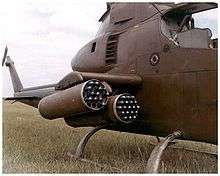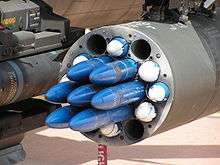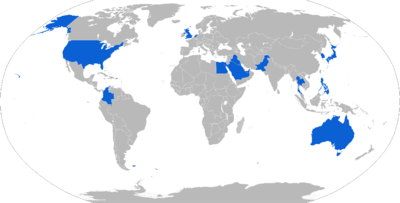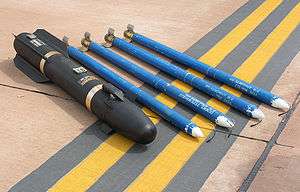Hydra 70
| Hydra 70 | |
|---|---|
|
Four dummy Hydra 70 rockets and an inert AGM-114 Hellfire | |
| Type | Rocket |
| Place of origin | United States |
| Service history | |
| In service | 1948–present[1] |
| Used by | See Users |
| Production history | |
| Unit cost | $2,799[1] |
| Specifications | |
| Weight | 13.6 lb (6.2 kg) (Mk 66 Mod 4 rocket motor only)[2] |
| Length | 41.7 in (1,060 mm) |
| Diameter | 2.75 in (70 mm) |
|
| |
| Muzzle velocity | 2,300 feet per second (700 m/s) |
| Effective firing range | 8,700 yards (8,000 m) |
| Maximum firing range | 11,500 yards (10,500 m) |
|
| |
| Speed | 2,425 ft/s (739 m/s) |
Guidance system | unguided |
Launch platform | AH-64 Apache, AH-1Z Viper, AH-1 Cobra, OH-58 Kiowa, T-129, Eurocopter Tiger, A-10 Thunderbolt II, UH-60 Black Hawk, P-3 Orion, MH-6 Little Bird, F-16 Fighting Falcon, F/A-18 Hornet, AV-8B Harrier II[2] |
The Hydra 70 rocket is a 2.75-inch fin-stabilized unguided rocket used primarily in the air-to-ground role. It can be equipped with a variety of warheads, and in more recent versions, guidance systems for point attacks. The Hydra is widely used by US and allied forces, competing with the Canadian CRV-7 which is physically interchangeable.
Overview
The Hydra 70 is derived from the 2.75-inch Mk 4/Mk 40 Folding-Fin Aerial Rocket developed by the United States Navy for use as a free-flight aerial rocket in the late 1940s. The Mk 40 was used during the Korean and Vietnam wars, being used to provide close air support to ground forces from about 20 different firing platforms, both fixed-wing and armed helicopters.
The main change made to produce the Hydra was the Mk. 66 motor which uses a new propellant that offers considerably more thrust, 1,335 pounds-force (5,940 N) (Mod 2/3) 1,415 pounds-force (6,290 N) (Mod 4). The fins of the Mk 40 flipped forward from the rear when the rocket left the launching tube, but in the Hydra they are curved to match the outside diameter of the rocket fuselage and flip sideways to open, which is referred to as WAFAR (Wrap-Around Fin Aerial Rocket) instead of FFAR (folding-fin aerial rocket). To improve stability during the time while the fins are still opening, the four motor nozzles have a slight cant angle to impart a spin while the rocket is still in the launch tube.
Today, the OH-58D(R) Kiowa Warrior and AH-64D Apache Longbow, as well as the Marine Corp's AH-1 Cobra, carry the Hydra rocket launcher standard on its weapon pylons.[3][4]
Mk 66 rocket motor variants
| Designation | Description |
|---|---|
| Mk 66 Mod 0 | 70 mm (2.75 in) WAFAR universal motor; common motor for the GD Hydra 70 series of rockets; original prototype; for US Army |
| Mk 66 Mod 1 | Mk 66 variant; production variant; for US Army |
| Mk 66 Mod 2 | Mk 66 Mod 1 variant; HERO (Hazards of Electromagnetic Radiation to Ordnance) safe; for US Navy and US Air Force |
| Mk 66 Mod 3 | Mk 66 Mod 1 variant; HERO safe; Mk 66 Mod 2 for US Army |
| Mk 66 Mod 4 | Mk 66 Mod 2/3 variant; incorporates a Salt rod to reduce exhaust gases; for all services |
| Mk 66 Mod 5 | Mk 66 Mod 4 variant; Incorporates propellant venting during fast cook off |
| Mk 66 Mod 6 | Mk 66 Mod 4/5 variant; designed to reduce the tendency of secondary launch gasses to combust in the parent aircraft’s engine, primarily with the AH-64 helicopter |
Service

The family of Hydra 70 (70 mm) 2.75 inch rockets perform a variety of functions. The war reserve unitary and cargo warheads are used for anti-materiel, anti-personnel, and suppression missions. The Hydra 70 family of folding-fin aerial rockets also includes smoke screening, illumination, and training warheads. Hydra 70 rockets are known mainly by either their warhead type or by the rocket motor designation, Mk 66 in US military service.
United States
In the U.S. Army, Hydra 70 rockets are fired from the AH-64A Apache and AH-64D Apache Longbow helicopters using M261 19-tube rocket launchers, and the OH-58D Kiowa Warrior using seven-tube M260 rocket launchers. In the U.S. Marine Corps, either the M260 or M261 launchers are employed on the AH-1 Cobra and future AH-1Z Viper, depending upon the mission. The M260 and M261 are used with the Mk 66 series of rocket motor, which replaced the Mk 40 series. The Mk 66 has a reduced system weight and provides a remote fuze setting interface. Hydra 70s have also been fired from UH-60 and AH-6 series aircraft in US Army service.
The AH-1G Cobra and the UH-1B "Huey" used a variety of launchers including the M158 seven-tube and M200 19-tube rocket launchers designed for the Mk 40 rocket motor; however, these models have been replaced by upgraded variants in the U.S. Marine Corps because they were not compatible with the Mk 66 rocket motor. The Hydra 70 rocket system is also used by the U.S. Navy, and the U.S. Air Force.
Common U.S. Mk 66 compatible launchers

| Designation | Description |
|---|---|
| M260 | 7-Tube LWL (LightWeight Launcher) |
| M261 | 19-Tube LWL (LightWeight Launcher) |
| LAU-130/A | 19-Tube rocket launcher |
| LAU-131/A | 7-Tube rocket launcher |
| LAU-68D/A | 7-Tube LAU-68C/A variant; compatible w/ Mk 66 rocket motor; external thermal protection coating; launcher supports single and ripple firing |
| LAU-61C/A | 19-Tube LAU-61B/A variant; compatible w/ Mk 66 rocket motor; external thermal protection coating; launcher supports single and ripple firing |
Warheads
Hydra 70 warheads fall into three categories:
- Unitary warheads with impact-detonating fuzes or remote-set multi-option fuzes.
- Cargo warheads with air burst-range, with setable fuzes using the "wall-in-space" concept or fixed standoff fuzes.
- Training warheads.
Fuzing options
| # | Designation | Description | Arming Range, Acceleration or Time |
|---|---|---|---|
| 1 | M423 | Nose Mount, Point Detonating for slow speed platforms (helicopters) | 47 to 102 yards (43 to 93 m) |
| 2 | M427 | Nose Mount, Point Detonating for high speed platforms | 197 to 466 yards (180 to 426 m) |
| 3 | XM436 | Air burst, Motor-Burnout Delay | |
| 4 | XM438/M438 | Nose Mount, Point Detonating | |
| 5 | M440 | Point Detonating | |
| 6 | Mk 352 Mod 0/1/2 | Point Detonating | |
| 7 | M429 | Proximity Air burst | |
| 8 | M433 | Nose Mount, Resistance Capacitance (RC) | SuperQuick (PD) 11 to 49 yards (10 to 45 m) Delay in 5.5 yards (5.0 m) increments including 3.3 yards (3.0 m) Bunker penetrating option |
| 9 | M439 | Base Mount, Resistance Capacitance (RC), Payload Discharging Pilot-Selectable | Discharges SMs between 547 and 7,874 yards (500 and 7,200 m) (766 to 7,546 yards [700 to 6,900 m] on AH-1s) 27Gs |
| 10 | M442 | Air burst, Motor-Burnout Delay | Discharges Flare at 3,281 yards (3,000 m), 17-22 g required for arming |
| 11 | M446 | Base Mount, Air burst, Motor-Burnout Delay | |
| 12 | Model 113A | Base Mount, Air burst, Motor-Burnout Delay |
Common warheads
The most common warhead for the Hydra 70 rocket is the M151 "10-Pounder," which has a blast radius of 10 meters and lethal fragmentation radius of around 50 meters.[5]
| Designation | Description | Weight | Payload | Fuze Type | Fuzing options |
|---|---|---|---|---|---|
| M151 | High explosive (HEPD) '10 pounder' | 8.7 pounds (3.9 kg) (w/o Fuze) | 2.3 pounds (1.0 kg) Comp B-4 HE | M423 | 1,2,5,7,8 |
| M156 | White phosphorus munitions (WP) | 9.65 pounds (4.38 kg) | 2.2 pounds (1.00 kg) WP | M423 M429 | 1,2,6,7 |
| M229 | High explosive (HEPD); elongated M151 '17 pounder' | 17.0 pounds (7.7 kg) (Fuzed) | 4.8 pounds (2.2 kg) Comp B-4 HE | M423 | 1,2,6,7 |
| XM245 | Submunition warhead possibly a modernized XM80/XM99 | 32 XM100 CS canisters | 3 | ||
| M247 | High-explosive anti-tank (HEAT)/high-explosive dual purpose (HEDP) | 8.8 pounds (4.0 kg) | 2.0 pounds (0.91 kg) Comp B HE | M438 PD | 4 (integral to warhead) |
| M255 | APERS (anti-personnel) warhead | 2500 28 grains (1.8 g) flechettes | 9 | ||
| M255E1/A1 | Flechette warhead | 14.0 pounds (6.4 kg) | 1179 60 grains (3.9 g) flechettes | M439 | 9 |
| M257 | Parachute illumination | 11.0 pounds (5.0 kg) | One M257 Candle (Flare) 1 million candela | M442 | 10 (integral to warhead) |
| M259 | White phosphorus (WP) | 9 | |||
| M261 | Multi-purpose submunition (MPSM) | 13.5 pounds (6.1 kg) | 9 M73 (Grenade) Submunitions | M439 with M84 electric detonator | 9 |
| M264 | Red phosphorus (RP) Smoke | 8.6 pounds (3.9 kg) | 72 RP Pellets | M439 | 9 |
| M267 | MPSM Practice | 13.5 pounds (6.1 kg) | Three Marking SMs, 6 Metal Weights | M439 with M84 electric Detonator | 9 |
| M274 | Practice (Smoke) | 9.3 pounds (4.2 kg) | 2 ounces (57 g) of potassium perchlorate and aluminum powder | M423 | 1 |
| M278 | Infra-red (IR) parachute illumination | 11.0 pounds (5.0 kg) | One M278 IR Flare | M442 | 10 (integral to warhead) |
| Mk 67 Mod 0 | White phosphorus (WP) | 1,2,6,7 | |||
| Mk 67 Mod 1 | Red phosphorus (RP) | 1,2,6,7 | |||
| WTU-1/B | Practice | 9.3 pounds (4.2 kg) | Inert | None | None |
| WDU-4/A | APERS warhead | 9.3 pounds (4.2 kg) | 96 flechettes of unknown weight | 12 (integral to warhead) | |
| WDU-4A/A | APERS warhead | 9.3 pounds (4.2 kg) | 2205 20 grains (1.3 g) flechettes | 12 (integral to warhead) |
NOTE: Though some of the warheads described were designed for the older Mk 40 rocket motor, but most likely could work with the Mk 66 motor if upgraded or modernized models were not available. However, this would not be necessary, as vast quantities of upgraded models exist today.
Mk 66 rocket motor technical data
Weight: 13.6 pounds (6.2 kg)
Length: 41.7 inches (1,060 mm)
Burn time: 1.05–1.10 sec
Average thrust (77 F):
- 1,335 lb (Mod 2/3)
- 1,415 lb (Mod 4)
Motor burnout range: 1,300 feet (400 m)
Motor burnout velocity: 2,425 ft/s (739 m/s)
Launch spin rate: 10 rps, 35 rps after exiting launcher
Velocity at launcher exit: 148 ft/s (45 m/s)
Acceleration:
- 60–70 g (initial)
- 95–100 g (final)
Effective Range: 547 to 8,749 yards (500 to 8,000 m) depending on warhead and launch platform
Maximum Range: 11,483 yards (10,500 m) under optimum conditions
Precision guided Hydra 70
There are several design efforts to turn the Hydra 70 rocket into a precision guided munition (PGM) to produce a weapon with greater accuracy but at less cost than other guided missiles. These include:
- The BAE Systems Advanced Precision Kill Weapon System (APKWS) II
- U.S. Navy Low-Cost Guided Imaging Rocket (LOGIR)
- Lockheed Martin Direct Attack Guided Rocket (DAGR)
- The ATK/Elbit Guided Advanced Tactical Rocket – Laser (GATR-L)
- Raytheon TALON
- Thales Group Roquette à Précision Métrique (RPM).[6]
- Forges de Zeebrugge SAL-Laser Guided Rocket (FZ275 LGR) [7]
The APKWS was the first to be fielded in March 2012,[8] and the TALON entered full rate production for the United Arab Emirates Armed Forces in September 2014.[9]
Roketsan Cirit is a similar missile compatible with 70 mm rocket launchers, but it was developed from scratch and doesn't use Hydra 70 components.[10]
Operators

Current operators
-
 Australia
Australia -
 Egypt
Egypt -
 Iraq
Iraq -
 Kuwait
Kuwait -
 Pakistan
Pakistan -
 Philippines,[11] The launchers are mounted on AS-211 "Warrior" trainers with secondary combat capability, SF-260 light attack aircraft and 520MG Defender helicopters.[11]
Philippines,[11] The launchers are mounted on AS-211 "Warrior" trainers with secondary combat capability, SF-260 light attack aircraft and 520MG Defender helicopters.[11] -
 Saudi Arabia
Saudi Arabia -
 Singapore
Singapore -
 South Korea
South Korea -
 Thailand
Thailand -
 United Arab Emirates
United Arab Emirates
See also
- U.S. Army Aviation and Missile Command
- CRV-7
- FFAR rocket 2.75 in (70 mm)
- SNEB rocket (68mm)
- FZ air-to-ground rockets 70mm/2.75"
- Zuni 5 in (127 mm)
References
- 1 2 Rockets galore
- 1 2 Hydra-70 2.75-inch (70mm) family of rockets (PDF), General Dynamics Armament and Technical Products, 2012, p. 2.
- ↑ "Hydra 70", Munitions, Military, Global Security.
- ↑ Hydra 70 (PDF), GDATP.
- ↑ New laser-guided rocket capability tested - AF.mil, 3 October 2016
- ↑ RPM on target for French Tigers - Flightglobal.com, 16 May 2013
- ↑ - IHS Jane, 13 January 2016
- ↑ U.S. Marines Field APKWS Guided Rocket in Afghanistan - Ainonline.com, 27 April 2012
- ↑ Raytheon begins full rate production on TALON Laser Guided Rockets for the UAE - Raytheon new release, 15 September 2014
- ↑ http://armadainternational.com/assets/images/pdf/Laser-Guided_Rockets.pdf
- 1 2 http://kalasagnglahi.angelfire.com/main.html
External links
- "Hydra 70". GlobalSecurity. Retrieved 2005-09-01.
- Hydra-70 Rockets: From Cutbacks to the Future of Warfare, Defense Industry Daily, April 2006.
- Air-Launched 2.75-Inch Rockets, Designation Systems.
- "Hydra-70", Warheads energetics, Weapon Systems, General Dynamics.
- 2012 Army Weapon Systems Handbook
